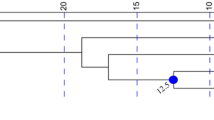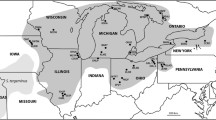Abstract
An important application of DNA-based genetic techniques in conservation genetics is to establish the taxonomic identity of individuals whose ancestry is uncertain, especially those from declining populations. Massasauga rattlesnakes (Sistrurus catenatus) in Missouri currently persist in three isolated populations and have been classified as eastern massasauga rattlesnakes (S. c. catenatus), which is a candidate for listing as a Federally Threatened or Endangered species. However, previous morphological evidence has suggested that these snakes are either hybrids between the eastern massasauga (S. c. catenatus) and the non-threatened western massasauga (S. c. tergeminus) or are pure S. c. tergeminus. Here, we analyze microsatellite DNA and mtDNA variation to assess the taxonomic identity of individuals from two of the three populations specifically those found in Holt and Linn Counties, Missouri. Population and phylogenetic analyses strongly support the conclusion that snakes in both populations are genetically most similar to reference S. c. tergeminus individuals from Kansas and are not related to S. c. catenatus individuals from Illinois and Ohio. These results argue that the current classification of these snakes as endangered S. c. catenatus is unwarranted and hence that the overall range-wide numbers of S. c. catenatus are less than previously estimated. Nonetheless the Missouri populations, while not part of the federally listed taxon, are strongly deserving of protected status at the state level because of their rarity within the state.



Similar content being viewed by others
References
Anderson CS, Gibbs HL, Chiucchi J (2010) Nineteen polymorphic microsatellite loci isolated from the eastern massasauga rattlesnake, Sistrurus c. catenatus. Conserv Genet Resour. doi:10.1007/s12686-010-9253-y
Bowen BW, Avise JC (1996) Conservation genetics of marine turtles. In: Avise JC, Hamrick JL (eds) Conservation genetics: case histories from nature. Kluwer Academic Publishers, Norwell, MA, p 397
Burbrink FT, Lawson R, Slowinski JB (2000) Mitochondrial DNA phylogeography of the polytypic North American rat snake (Elaphe obsoleta): a critique of the subspecies concept. Evolution 54:2107–2118
Campbell JA, Brodie ED Jr, Barker DG, Price AH (1989) An apparent natural hybrid rattlesnake and Crotalus willardi (Viperidae) from the Peloncillo mountains of southwestern New Mexico. Herpetologica 45:344–349
Chapuis MP, Estoup A (2007) Microsatellite null alleles and estimation of population differentiation. Mol Biol Evol 24:621–631
Chiucchi JE, Gibbs HL (2010) Similarity of contemporary and historical gene flow among highly-fragmented populations of an endangered rattlesnake. Mol Ecol. doi:10.1111/j.1365-294X.2010.04860.x
Culver M, Johnson WE, Pecon-Slattery J, O’Brien SJ (2000) Genomic ancestry of the American puma (Puma concolor). J Hered 91:186–197
Daugherty CE, Cree A, Hay J, Thompson MB (1990) Neglected taxonomy and continuing extinctions of tuatara (Sphenodon). Nature 347:177–179
Drummond AJ, Rambaut A (2007) BEAST: Bayesian evolutionary analysis by sampling trees. BMC Evol Biol 7:214
Emerson BC, Wallis GP (1994) Phylogenetic relationships of the Prodontria (Coleoptera; Scarabaeidae; Subfamily Melolonthinae), derived from sequence variation in the mitochondrial cytochrome oxidase II gene. Mol Phylogenet Evol 4:433–447
Evans PD, Gloyd HK (1948) The subspecies of the massasuaga, Sistrurus catenatus, in Missouri. Bull Chicago Acad Sci 8:225–232
Frankham R, Ballou JD, Briscoe DA (2002) Introduction to conservation genetics. Cambridge University Press, Cambridge
Friedman M, DeSalle R (2008) Mitochondrial DNA extraction and sequencing of formalin-fixed archival snake tissue. Mitochondrial DNA 19:433–437
Gibbs HL, Diaz J (2010) Identification of single copy nuclear DNA markers for North American pit vipers. Mol Ecol Resour 10:177–180
Gibbs HL, Sanz L, Calvete JJ (2009) Snake population venomics: Proteomics-based analyses of individual variation reveals gene regulation effects on venom protein expression in Sistrurus rattlesnakes. J Mol Evol 68:113–125
Haig S, Wadner RS, Forsman ED, Mullins TD (2001) Geographic variation and genetic structure of spotted owls. Conserv Genet 2:25–40
Hart SN, Durbian FE, Dillman CB, Eckdahl TT (2008) Assessment of allelic variation among massasauga rattlesnake populations via microsatellite analysis. Trans Missouri Acad Sci 42:1–9
Keogh SJ, Scott IAW, Fitzgerald M, Shine R (2003) Molecular phylogeny of the Australian venomous snake genus Hoplocephalus (Serpentes, Elapidae) and conservation genetics of the threatened H. stephensii. Conserv Genet 4:57–65
Kinziger AP, Loudenslager EJ, Hakin DG et al (2008) Hybridization between spring- and fall-run chinook salmon returning to the Trinity River, California. North Am J Fish Manag 28:1426–1438
Kubatko LS, Gibbs HL, Bloomquist E (2010) Inferring species-level phylogenies and taxonomic distinctiveness using multi-locus data in Sistrurus rattlesnakes. Syst Biol (in press)
Meng C, Kubatko LS (2009) Detecting hybrid speciation in the presence of incomplete lineage sorting using gene tree incongruence: a model. Theor Popul Biol 75:35–45
Missouri Department of Conservation (2000) Missouri Animals of Conservation Concern. Jefferson City, MO
Murphy RW, Crabtree CB (1988) Genetic identification of a natural hybrid rattlesnake: Crotalus scutulatus scutulatus × C. viridis viridis. Herpetologica 44:119–123
Parham JF, Simison WB, Kozak KH, Feldman CR, Shi H (2001) New Chinese turtles: Endangered or invalid? A reassessment of two species using mitochondrial DNA, allozyme electrophoresis, and known locality specimens. Anim Conserv 4:357–367
Posada D, Crandall KA (1998) MODELTEST: testing the model of DNA substitution. Bioinformatics 14:817–818
Pritchard JK, Stephens M, Donnelly P (2000) Inference of population structure using multilocus genotype data. Genetics 155:945–959
Sambrook J, Fritsch EF, Maniatis T (1989) Extraction with phenol:chloroform. In: Molecular Cloning: A laboratory manual, pp. E.3-E.4. Cold Spring Harbor Laboratory Press, Plainview
Seutin G, White BN, Boag PT (1991) Preservation of avian blood and tissue samples for DNA analyses. Can J Zool 69:82–90
Stuart BL, Parham JF (2007) Recent hybrid origin of three rare Chinese turtles. Conserv Genet 8:169–175
Sumner J, Webb JK, Shine R, Keogh JS (2010) Molecular and morphological assessment of Australia’s most endangered snake, Hoplocephalus bungaroides, reveals two evolutionarily significant units for conservation. Conserv Genet 11:747–758
Swofford, D (2000) PAUP* 4.0b10. Sunderland, Massachusetts, USA
Szymanski J (1998) Status assessment for eastern Massasauga (Sistrurus c. catenatus). U.S. Fish and Wildlife Service, Fort Snelling, Minnesota
U. S. Fish and Wildlife Service (2008) Endangered and threatened wildlife and plants; review of native species that are candidates for listing as endangered or threatened; annual notice of findings on resubmitted petitions; annual description of progress on listing actions; proposed rule. Federal Register 73:75175‐75244
Wayne R (1996) Conservation genetics in the Candidae. In: Avise JC, Hamrick JL (eds) Conservation genetics: case histories from nature. Chapman & Hall, New York, pp 75–118
Wilson PJ, Grewal S, Lawford JNM et al (2000) DNA profiles of the eastern Canadian wolf provide evidence for a common evolutionary history independent of the grey wolf. Can J Zool 78:2156–2166
Acknowledgments
We especially thank Trish Crabill, Frank Durbian, and Rich Seigel for much appreciated assistance in obtaining samples from Missouri, and David Bender, Travis Taggart, Curtis Schmidt, and Joe Collins for their generous hospitality and help in obtaining samples in Kansas. Jose Diaz gave advice in the lab, Katy Greenwald, Mike Redmer, and Rich Seigel commented on the manuscript, and The Ohio State University College of Arts and Sciences and College of Biological Sciences provided financial support.
Author information
Authors and Affiliations
Corresponding author
Electronic supplementary material
Below is the link to the electronic supplementary material.
Rights and permissions
About this article
Cite this article
Gibbs, H.L., Murphy, M. & Chiucchi, J.E. Genetic identity of endangered massasauga rattlesnakes (Sistrurus sp.) in Missouri. Conserv Genet 12, 433–439 (2011). https://doi.org/10.1007/s10592-010-0151-3
Received:
Accepted:
Published:
Issue Date:
DOI: https://doi.org/10.1007/s10592-010-0151-3




